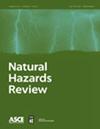在COVID-19大流行期间,韩国移民对疾病的感知脆弱性、恢复力和心理健康结果:一种机器学习方法
IF 1.8
3区 工程技术
Q3 ENGINEERING, CIVIL
引用次数: 0
摘要
本研究考察了感知疾病脆弱性(PVD)、对新冠肺炎的恐惧以及应对机制对韩国移民在疫情期间心理困扰水平的预测能力。通过有目的的抽样,18岁以上居住在美国的外国出生和美国出生的韩国移民都被邀请参加一项在线调查。2020年5月至6月,进行了数据收集,最终产生了来自42个州的790名参与者的样本。使用人工神经网络(ANN)来验证预测参与者心理痛苦程度的变量。具有一个包含六个隐藏神经元的隐藏层的模型显示出最佳性能。错误率约为27%,敏感性分析的结果,即受试者工作特性(ROC)曲线,显示曲线下面积(AUC)为0.801。神经网络中最有力的预测变量是弹性、PVD和社会支持。讨论了对实践和政策的影响。本文章由计算机程序翻译,如有差异,请以英文原文为准。
Perceived Vulnerability to Disease, Resilience, and Mental Health Outcome of Korean Immigrants amid the COVID-19 Pandemic: A Machine Learning Approach
This study examined the predictive ability of perceived vulnerability to disease (PVD), fear of COVID-19, and coping mechanisms on the Korean immigrants' psychological distress level amid the pandemic. Through purposive sampling, both foreign-born and US-born Korean immigrants residing in the US above the age of 18 years were invited to an online survey. Between May and June 2020, data collection took place, which yielded the final sample of 790 participants from 42 states. An artificial neural network (ANN) was used to verify variables that predict the level of psychological distress on the participants. The model with one hidden layer holding six hidden neurons showed the best performance. The error rate was approximately 27%, and the results from the sensitivity analysis, the receiver operating characteristics (ROC) curve, showed that the area under the curve (AUC) was 0.801. The most powerful predicting variables in the neural network were resilience, PVD, and social support. Implications for practice and policy are discussed.
求助全文
通过发布文献求助,成功后即可免费获取论文全文。
去求助
来源期刊

Natural Hazards Review
ENGINEERING, CIVIL-GEOSCIENCES, MULTIDISCIPLINARY
CiteScore
4.90
自引率
7.40%
发文量
72
审稿时长
3 months
期刊介绍:
The Natural Hazards Review addresses the range of events, processes, and consequences that occur when natural hazards interact with the physical, social, economic, and engineered dimensions of communities and the people who live, work, and play in them. As these conditions interact and change, the impact on human communities increases in size, scale, and scope. Such interactions necessarily need to be analyzed from an interdisciplinary perspective that includes both social and technical measures. For decision makers, the risk presents the challenge of managing known hazards, but unknown consequences in time of occurrence, scale of impact, and level of disruption in actual communities with limited resources. The journal is dedicated to bringing together the physical, social, and behavioral sciences; engineering; and the regulatory and policy environments to provide a forum for cutting edge, holistic, and cross-disciplinary approaches to anticipating risk, loss, and cost reduction from natural hazards. The journal welcomes rigorous research on the intersection between social and technical systems that advances concepts of resilience within lifeline and infrastructure systems and the organizations that manage them for all hazards. It offers a professional forum for researchers and practitioners working together to publish the results of truly interdisciplinary and partnered approaches to the anticipation of risk, loss reduction, and community resilience. Engineering topics covered include the characterization of hazard forces and the planning, design, construction, maintenance, performance, and use of structures in the physical environment. Social and behavioral sciences topics include analysis of the impact of hazards on communities and the organizations that seek to mitigate and manage response to hazards.
 求助内容:
求助内容: 应助结果提醒方式:
应助结果提醒方式:


